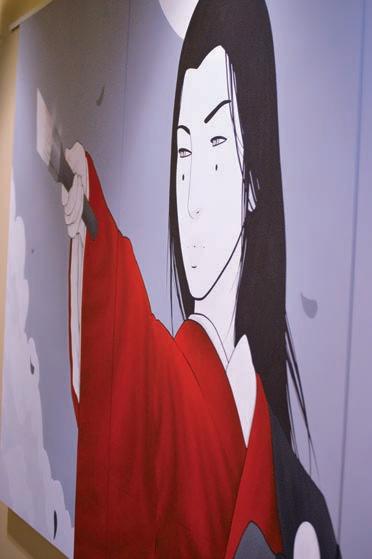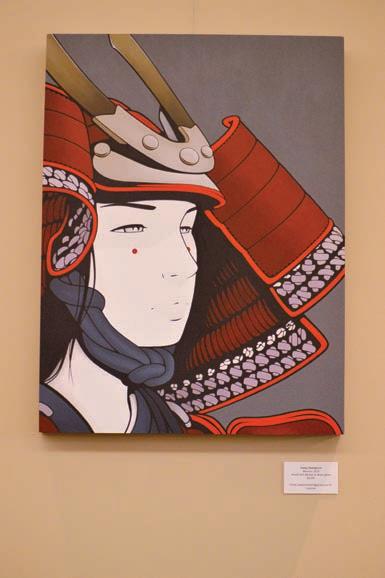
3 minute read
ARTIST
that sort of developed over my, really, my whole life,” he said. “It is, I feel, like a representation of myself.”
Kawaguchi always had Japanese inspiration, he said. He grew up in Utah, where he was around a tightknit Japanese community.
“It’s always been a strong part of my identity,” he said. “As I’ve gotten older … I’ve realized these inspirations from when I was a kid have come out in my work.”
As part of the reception, Kawaguchi showed videos of a documentary that captured some of the most meaningful work he has created.
When he paints the walls to create a mural, he sees it as being similar to martial arts, he said. He described it as a physical meditation and a practice of something that is internal.
“ e practice of it is allowing something that’s internal to grow alongside of the physical practice,” he said. “ e practice of doing it is, like, something you never get to, and it is a practice — like a target you’re aiming at but you never hit.”
Part of his path as an artist was realizing that he can take something negative and out of his control, and use his artwork as a way to transform that struggle and give it new meaning, creating something that can inspire others.
“And so, making art, I feel like, is a necessity to me,” he said. “I think being able to convey that and share it is part of my purpose.”
Kawaguchi’s interest in artwork started at a young age because his older brother had a talent for draw- ing, becoming Kawaguchi’s earliest inspiration.
“I grew up drawing from photos and comic books and almost, just, obsessively trying to perfect what I was drawing,” he said. “But then, when I started to go away from reference and just drawing from my imagination, there was a turning point.
“And that was, I feel like, the start of what became my character.”
Over time, Kawaguchi began painting and found an interest in spray painting.
“I never would have imagined being able to have these opportunities and painting murals that are seen by so many people when I was a kid,” he said. e family told Kawaguchi that they had to bring the young boy because he had seen Kawaguchi’s work and was inspired, starting to draw samurai himself. ese opportunities to share his artwork with young people excites him, he said.
One interaction that has stuck with Kawaguchi was when he was painting a mural and a family came by with a young boy around the age of 7.
“ ey wanted to bring him by and show him in person the painting,” Kawaguchi said.


Wanting to enhance the young boy’s experience, Kawaguchi let the boy use spray paint for the rst time and tag his name on Kawaguchi’s wall.
“I imagined if I had seen people painting, like painting a large mural or using spray painting and stu , when I was a little kid, it would’ve changed — it would’ve changed my life,” he said.
Among the crowd of people who gathered to see Kawaguchi and his work was Jenni DeWitt Walker and her husband and two daughters.
DeWitt Walker often checks what is happening at Arapahoe Libraries, and given her 14-year-old daughter, Rayanne Walker, has a passion for art, the family decided to attend the reception.
“It was amazing. His artwork is incredible,” Dewitt Walker said about the event. “It’s very, like, awe-inspiring for me.” Rayanne’s favorite part of the night was seeing Kawaguchi’s artwork, she said, adding that she was interested to hear how he got to where he is today, especially given that he is self-taught.
For Kawaguchi, his favorite part was the opportunity to convey in words what he feels about his art.
He said he hopes attendees connected with their own source of inspiration and gathered the message that when they nd something that inspires them, that is a compass for them to follow.
“ ose things that you do feel, the inspiration you do feel — there’s a reason why you feel that,” he said. “You not only can but are meant to do that.”
“Follow your heart.” ose interested in learning more about Kawaguchi can visit his website, caseykawaguchi.com. To see a map of where his murals are, visit bit.ly/muralmaps.
FROM
PAGE public libraries. DCL brings in major authors like Lisa See, Luis Alberto Urrea and John Gierach to name a few from earlier this year. DCL also helps immigrants prepare for U.S. citizenship and gain confidence in English. There is a safe and supportive environment for anyone who seeks help in improving their literacy skills.
Volunteering at the library helps not only the library but the entire community, states Curtain. There are rewarding and challenging opportunities for volunteers, from teens to centenarians. Volunteering at the library also provides an opportunity for social connection in ways that are comfortable for both introverts and extroverts.
Volunteering also has the potential to transform people’s lives as volunteers help adults learn English or prepare for high school equivalency exams or develop basic literacy skills. Volunteers also help invigorate the love of reading with children or ensure that people can quickly and easily access their items on hold.
The vision for Douglas County Libraries is to elevate the commu- nity by inspiring a love of reading, discovery and connection. Every person embodies a story that ensures the vivacity of the community.









